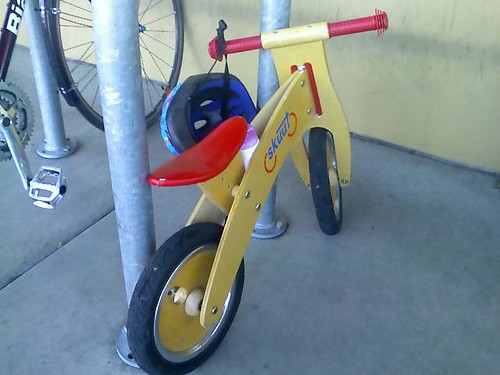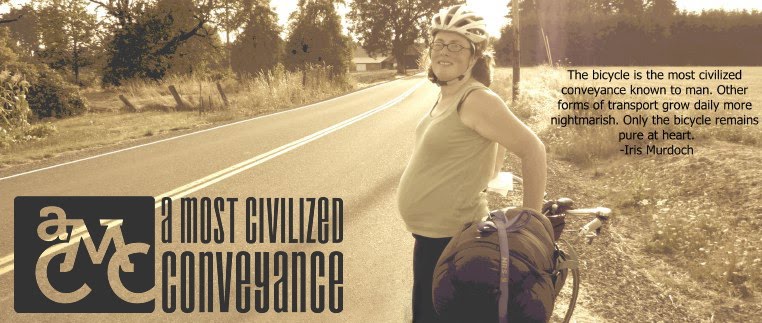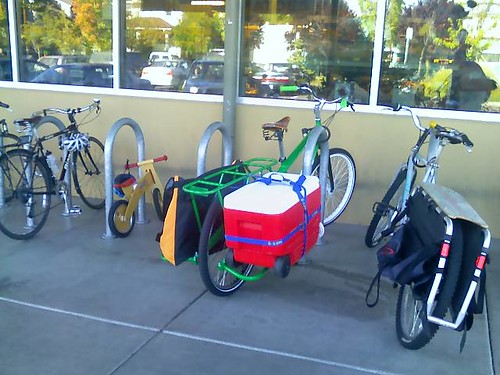Wednesday, August 26, 2009
Trip, Madsen
Tuesday, August 25, 2009
New Seasons Bike Rack, 24 August 2009
When we rolled up to New Seasons for groceries yesterday, we found ourselves in excellent company. To the Mundo's right, a well-loved, well-battered xtracycle. And to its right, a tiny Skuut! The Skuut was not locked, just leaned, along with its rider's tiny helmet. Overwhelmingly cute. Observe, the close-up:
My question: how will this intrepid skuuter get home his or her groceries without better cargo capacity? Has the time come for the cargo push-bike?
Sunday, August 23, 2009
Gross.
I smelled it first. Urine, certainly, but being a pregnant woman riding through urban spaces, that isn't unusual.
But then, coming down off the west side of the Broadway Bridge, there was something wet on the road. Which I didn't connect with the increasingly powerful urine smell until...
SPLASH! I don't know what this stuff was. Septic spill? Leaky portapotty? It was more urine than urine; thick, putrid stuff. And I didn't have my fenders on.
We hurried home, my sundress-and-sandals outfit suddenly seeming like the worst idea I'd possibly ever had. Clothes into the laundry, me into the shower, bikes onto the porch. Dave did the bike-cleaning duty (he was riding with both fenders and pants, so the trauma was less). Once showered and laundered, I called the city pollution line to let them know there was... stuff... on the road.
I love riding my bike because it makes me feel connected to my city. But tonight Portland, I discovered just how close is too close. That's a connection I just don't need.
If you need it: Portland Pollution Reporting Line, 24 Hours: 503-823-7180
Tuesday, August 18, 2009
Rear hub tech notes
Things have been busy around here, but I want to start getting some of the technical stuff from the Yuba build posted. Answering a comment, the rear hub is a Halo Spin Doctor Pro DH. Halo is a UK firm that designs relatively affordable freeride/dirt-jumping parts. The SD Pro rear hub is a cartridge-bearing design with interchangeable freehubs and a few different axle configurations. The DH version comes with the chromoly freehub and 10mm hollow chromoly bolt-on axle installed in a hubshell drilled for 48 spokes. Parts are available to adapt the 10mm bolt-on axle to 14mm, which is the only reason I went with this hub. I wanted a freehub so that I could run a modern 9-speed 11-34T cassette with a single ring up front to get the widest gear range with minimal parts.
I love the Mundo frame for it's strength, but its targeted selling price appears to have forced some design decisions I would've avoided. The Yuba has one of the most ridiculous dropout configurations I've ever seen: 130mm x 14mm. The 130mm spacing is the width of a modern road bike, but the 14mm axle diameter is only used in heavy-duty BMX parts. The stock wheel that Mundos come with has a BMX hub with a longer 14mm axle installed. They can do this beacause the hub has simple cup-and-cone bearings, and the axle is just a piece of threaded rod. The rear cogs on the Mundo 6- and 18-speed builds is a freewheel cluster, the only way you can get multiple gears onto a BMX hub that was designed to carry a single-cog freewheel.
Freewheel clusters have two major design problems: first, the right-side hub bearing is located under the right-side spoke flange, which is the entire width of the cluster away from the right-side dropout. The load of the bike is transferred to the axle at the dropout, and is transferred through the bearings to the hubshell. The length of axle spanning the distance from the dropout to the bearing is a mechanical beam, and the longer that beam is the stronger it needs to be to not bend under load. This is why the Mundo hub has a 14mm axle: the distance between the right-side bearing and dropout is large, and a 10mm axle would bend under the Mundo's rated load. The freehub design, where the freewheeling ratchet mechanism is part of the hub rather than the gear cluster, puts a bearing much closer to the right-side dropout, so a smaller axle can be used because it doesn't have to support the load over such a large distance.
This brings us to the second problem with freewheel clusters: due to the basic design reality described above, every quality hub intended for multi-gear usage from the last two decades or more uses a freehub. All the advances in shifting technology in that time frame and all decent parts currently in production were designed to work with a freehub cassette and quality freewheel clusters aren't made. So, if you want the shifting on your Mundo to work as well as on your "good" bike, a freehub is first on the list of replacement parts.
A Long Walk to Green solved the problem by brazing 4mm spacers into the dropouts to run a normal 10mm-axled hub (he used a Nuvinci CVT). The 130mm spacing isn't a barrier to fitting 135mm mountain bike hubs in a modified frame like that because the Mundo is made out of heavy steel, and you can just spread the stays apart a bit to fit the hub in there. It makes changing a tube a bit more arduous, but it's not a big deal. So, that's one way to go: modify the frame and a run a strong, standard hub.
I went another route and found the only freehub made that is intended for use with 14mm dropouts. The only problem with that is that the USA distributor for Halo, BTI, has the SKUs messed up for the Halo axle adaptors, and it's been six weeks now and I still don't have the ones for my rear hub. Instead I have two sets of adaptors for a front hub and a rear wheel that's held onto the bike by the skin of its teeth. It's been fine for groceries so far, but I'm not going to put a passenger back there until I have the right parts. If I knew it was going to be so arduous getting a part that the distributor lists as in-stock, I would've just planned on brazing in spacers and using a perhaps-stronger hub, like a Chris King, with their 22mm dropout-to-dropout axle that fits in a normal 10mm dropout. On the other hand, it might be been weird using a hub that cost almost as much as the frame.
The ultimate solution would probably involve a thru-axle and asymmetric 150mm dropout spacing like a modern downhill bike. That would give you more strength than the 14mm freewheel hub and lets you fit a modern 9-speed cassette and a disc brake while maintaining a large flange-to-flange distance and not having any dish in the wheel. The problem for Yuba would be getting such a part made at a cost that makes sense in developing nations.
Saturday, August 1, 2009
Everyday Riding with the Mundo
As previously mentioned, I've pretty much ridden two adult bikes ever, one a short-lived vintage Schwinn cruiser and one my now-modified Bianchi Volpe. So I don't have a great depth of experience to draw on as I talk about riding the Mundo.
Riding the Mundo, I feel BIG. Being six months pregnant, of course, helps with this sensation. The Mundo, like my bulging belly, takes up SPACE. I'm aware of the width of the H-racks even during unloaded riding, and when on a busy bike lane-- say, eastbound on Hawthorne around 5:30 pm-- I was at first self-conscious about how much space I was taking, and how slowly I was moving in comparison to the zippy hipster fixies passing me. But with a bit of practice at it, the experience became more relaxed, and I became more comfortable with the pace the bike requires of me.
The frame is significantly stiffer than my Volpe, with the unyielding fat frame tubing sending more jolts and bumps my way than I'm accustomed to. It's not an unpleasant ride, but I was surprised at how much difference riding a less-compliant frame could make. However, this bumpiness is much less pronounced when the bike is loaded-- I think this bike is happiest when it is weighed down at the rear, which is as it should be.
The ride while the bike is loaded (I'd guess 70 or 80 lbs of groceries) is smooth and stable. I'm still getting the hang of starting and stopping while loaded, and have occasionally teetered before catching my balance after a sudden stop, but I think that is a matter of skill and familiarity, rather than a problem with the bike. Riding under load feels pretty much like riding any other bike-- except slower, and heavier. But very, very stable.
The biggest failure so far is the kickstand, a Hebie BiPod. Rock the Bike recommends this for "everyday loading" but not for "true cargo" loading, but I don't see the distinction: the BiPod can't hold the bike upright when I'm loading several sacks of groceries, and so isn't nearly up for my "everyday" needs-- I certainly wouldn't use it while loading a kid onboard. We'll be upgrading this part soon.
We picked up a Go Getter bag from JoeBike here in town and I think it is awesome for quick-and-easy loading of things like sacks of groceries (holds two full paper-size sacks comfortably) or for just tossing a thing or two onto the bike without worrying about proper loading technique. The only thing that I don't love about the Go Getter is that is it quite so portable: great when I need to get the groceries up the elevator, of course, but a pain to always have to take the bag with me when I lock up the bike. Mike Cobb, the Go Getter's designer, mentioned working on a secure, rigid, lock-able, waterproof "trunk" to fit onto the Mundo's rear rack. This sort of car-like security would be a real boon when carrying out car-like tasks, including multi-stop errand runs.
By far the biggest hassle of the Mundo comes from our current living situation. We're in a small downtown apartment, and the Mundo is too unwieldy for the stairwell and just barely fits in the elevator. Our neglectful landlords have allowed all of what passes for bike parking in the parking garage get filled up with decrepit, abandoned bikes, so without anywhere secure to leave the beast at ground level, we keep it along with the rest of the stable in our apartment. This means that when leaving the apartment, we need to get around several tight corners, put the front half of the bike into the elevator, tip it up onto its front wheel to tuck the H-racks in, and then repeat this maneuver (crashing into walls all the while) to get out again. This works ok if we're working together, but for taking trips solo (as I have been these past couple weeks) it's a substantial hassle. If the bike is loaded, it becomes even more precarious, and I usually end up tucking the prospective load into the elevator first, then squeezing myself and the bike in after it, and re-loading once I reach the lobby.
Fortunately, this hassle will only persist another month, as we are leaving our current apartment for a cute little Ladd's Addition bungalow (with bike garage!) at the end of August. In the meantime, though, the 15 feet between the bike and the ground certainly make me carefully consider whether any given trip really needs cargo capacity.

